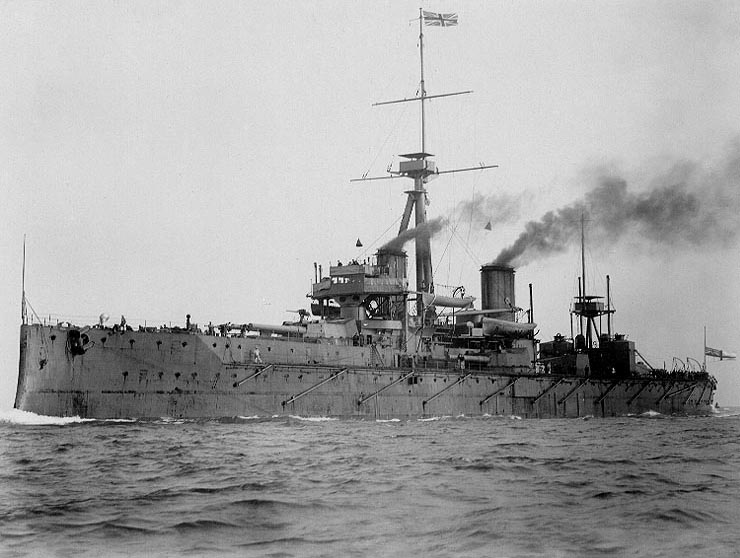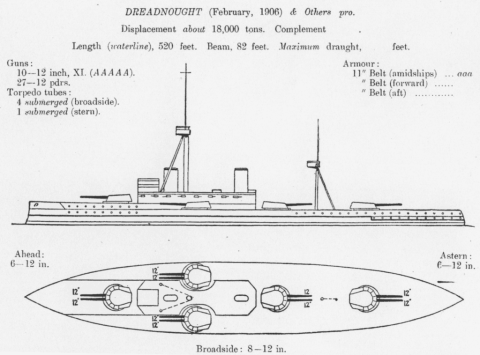BBC News Magazine looks back on the launch of the first modern all-big-gun battleship, HMS Dreadnought, in 1906.

HMS Dreadnought underway, circa 1906-07
[HMS Dreadnought] “really transformed naval warfare rather like the tank did on land warfare. In fact Dreadnought was described at the time as ‘the most deadly fighting machine ever launched in the history of the world'”.
Dreadnought brought together for the first time a series of technologies which had been developing over several years. Most important was her firepower. She was the first all big-gun battleship — with ten 12-inch guns. Each gun fired half-ton shells over 4ft tall and packed with high explosive. They weighed as much as a small car. Standing next to one today, it is easy to see how a single broadside could destroy an opponent — and do so at 10 miles’ distance.
These great distances caused problems of their own — in controlling and directing the fire — and Dreadnought was one of the first ships fitted with new equipment to electrically transmit information to the gun turrets.
For potential enemies on the receiving end this was a terrifying prospect. Admiral Lord West, a former head of the Royal Navy, calls Dreadnought “a most devastating weapon of war, the most powerful thing in the world”.
Potential adversaries would also have trouble outrunning her. New steam turbine engines gave her a maximum speed of about 25mph. They made her more reliable than previous ships, and able to sustain a higher speed for much longer.
But there was something else, too. Dreadnought had been built in just one year — a demonstration of British military-industrial might at a time when major battleships generally took several years to build. This, says Roberts, was an “enormous achievement which made the Germans sit up because their shipbuilding capability just could not match that”.

Despite the Royal Navy’s reputation for being tradition-bound and stodgy, they had quite an interesting history of experimentation and innovation in ship design. The launch of HMS Dreadnought was a good example of the navy being willing to take risks — specifically the risk of making the rest of the battlefleet obsolete overnight.
Update, 18 February, 2018: A recent post at Naval Gazing provides more information on the evolution of the Dreadnought design.

HMS Dreadnought in 1911
[Admiral Sir John “Jackie”] Fisher established a committee, including John Jellicoe and Reginald Bacon, who settled on the characteristics that would define Dreadnought. Bacon, later Dreadnought’s first captain – regarded by Fisher as “the cleverest officer in the Navy” – was the man who convinced Fisher to switch from all-10″ to all-12″. Reports of the effectiveness of the 12″ gun during the Russo-Japanese war helped confirmed this decision.
The second major change that Dreadnought brought is less obvious but in many ways more important. Dreadnought was the first large warship to use steam turbines instead of reciprocating engines. This increased her speed from the previous standard of 18 kts to 21 kts, saved 1000 tons, and most importantly allowed her to maintain high speed for much longer without the risk of mechanical failure. This was a vital component of Fisher’s other innovation, what we now call net-centric warfare. The high sustained speed of the new ships allowed them to cover greater areas, based on the improved information gathering and dissemination system that Fisher set up.
Dreadnought broke new ground in other areas, too. Her hull was about 18% lighter by volume than that of the proceeding Lord Nelson class, and she set a new standard for watertight integrity, removing most doors below the waterline. The only area without major improvement was armor, which was actually slightly less than in the Lord Nelson.
The design process began in November of 1905, initially with plans for 6 turrets. The first set of designs included the obvious (a hexagonal layout), the slightly less obvious (three superfiring turrets on each end) and the weird (a triangle at each end, with two turrets abreast and a superfiring turret above them). Eventually, it was decided that muzzle blast made the later two designs infeasible. Blast interference between the wing turrets meant that the aft pair was replaced by a single centerline turret, producing the arrangement used in Dreadnought.
The final result was a ship of 18,000 tons and 527 ft. With an 8-gun broadside, she matched the long-range firepower of almost any two ship afloat, and she set a new standard for speed in battleships. She was laid down on October 2nd, 1905, and launched only 5 months later, on February 10th, 1905. The 14 months exactly from laying down to commissioning set a record that has never been broken for capital ships, and was intended by Fisher to send a message to the world.
He also references the Dreadnought Hoax, which I’d never heard of … I’m surprised Cole wasn’t prosecuted as a spy, given the popular anxieties about foreign espionage and worries about an invasion.






